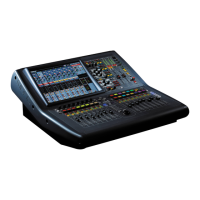138 Chapter 16: Internal Effects
PRO1 Live Audio System
Operator Manual
occurring. Thus, attacks are a little more aggressive but the adaptive nature of the
RMS detection is still allowed to operate to its fullest extent. This mode is good for
natural sounding limiting of speech.
Compressor hard knee and vintage
With the VINTAGE and HARD KNEE switches both switched on, the compressor
operates with more precise envelope control and, again, with a more defined transition
between under and over threshold. This mode uses faster peak sensing (not RMS), like
many older compressor designs with exponential attack and release. This produces
aggressive compression that gives good fast control and/or limiting of extremely
dynamic material. It can also be used to add colour to low frequency signals, making it
ideal for controlling instruments such as the bass guitar.
Compressor soft knee and vintage
With only VINTAGE switched on, the compressor employs a dual time constant, linear
attack profile. The soft knee blurring of threshold occurs once more, as in RMS mode,
although the effect is greatly accentuated. This produces extremely subtle attack and
release curves during the onset of compression that are largely independent of the
envelope control settings. As the compressor is driven harder (signals go further over
threshold) the soft knee effect reduces, gradually returning manual control of the attack
and release times to optimise capture of larger transients etc. Thus, like the RMS
modes, this compressor mode is very adaptive, making set-up of the envelope controls
relatively easy. However, the peak sensing increases harmonic overtones, adding a
valve-like brightness and sparkle to the programme, and producing extremely natural
and lively sounding compression of acoustic instruments.
Stereo and multiple channel operation - linking
Using the intermediate LINK switches, adjacent channels can be linked, in all modes,
for stereo or multi-channel operation. Linked channels form a group, the lowest
numbered channel in the group being the master and the other group members are
slaves. The master channel’s settings override those of the slaves with the exception of
bypass, solo, ext key and side chain filter, which still act independently. (The slave
filters, ext key and solo still function when linked because the slave channel side chain
is summed with the master and any other slaves in the group.)
You can have more than one group at any time; Figure 6 “Examples of channel linking”
shows some typical group configurations and illustrates that the master is always the
lowest numbered channel within the group.

